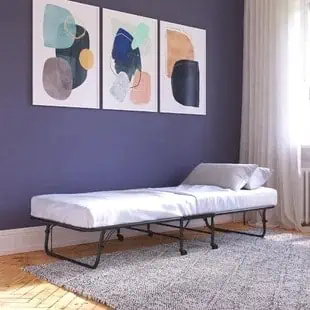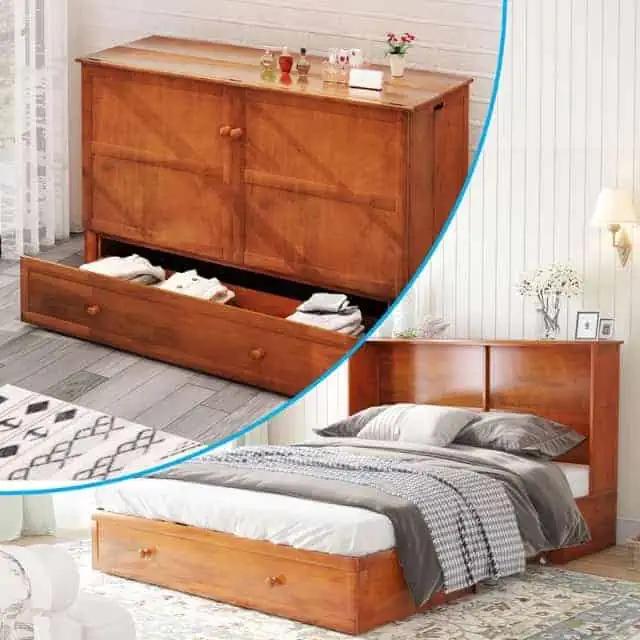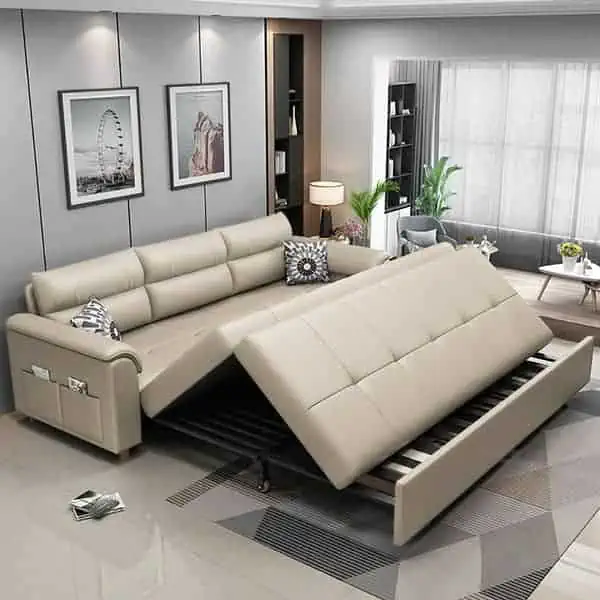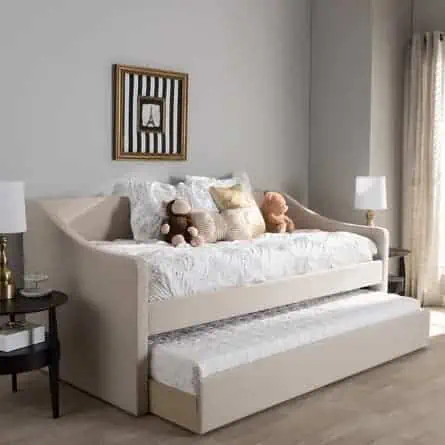
The need for affordable housing has never been greater. The decision to cut expenses or seek additional sources of income is tough.
According to HousingMatters.Urban.org, there is a need for more than 7.3 million affordable and available rental homes in the US.
Working as a licensed real estate agent, I see affordable housing becoming less available.
Shipping container homes are gaining popularity as housing prices rise. However, living in a small space can pose some challenges and most people fear the possibility of using such a small space.
Most people can live without a dining table or formal sofa but not a bed.
I have seen the power of the right design and furniture in these homes. This article will explore the best beds for shipping container homes.
We will discuss the platform bed, Murphy bed, loft bed, convertible bed, and custom pieces.
Key Takeaways
- The best beds for shipping containers are platform beds, loft beds, Murphy beds, convertible furniture, or custom-built pieces.
- The bed you select will be determined by what space needs you have.
- Planning for the bedroom layout in a shipping container can help maximize living space.
- Convertible furniture will allow for more functionality.
Table of Contents
Disclosure: This post may contain affiliate links, meaning I can earn commissions. If you decide to purchase through my links, it is at no cost to you.
What are the Best Beds for Shipping Container Homes?
The most popular bed options for shipping container homes are Murphy beds, folding beds, futons, and sleeper sofa beds.
These bed options are space-saving and functional, which makes them perfect for small living spaces.
1. Platform Beds: Simplicity and Functionality

The IKEA Malm platform storage bed with hidden storage

The IKEA Malm platform storage bed reveals the hidden storage
Pros: Platform beds are popular for shipping container homes due to their simplicity and functionality.
These beds consist of a solid platform that supports the mattress with built-in storage drawers and compartments or a mechanism to raise the mattress to utilize the entire space under the bed.
Cons: While platform beds offer practicality and customization options, they may need more elevated design and unique features of other bed types.
If you have a high ceiling in your shipping container home, you might prefer a bed that better uses the vertical space available.
2. Loft Beds: Maximizing Vertical Space

Pros: Loft beds are an excellent option for shipping container homes with higher ceilings. These beds are elevated and placed on a raised platform, maximizing the vertical space within the container.
While the bed can’t be too high because of the limited headspace, freeing up the space underneath is invaluable for storage.
Cons: One drawback of loft beds is the need for a safe and sturdy structure to support the elevated platform. Ensuring the loft bed is securely anchored is essential to prevent accidents or collapses is vital.
Additionally, climbing up and down from a loft bed can be challenging for individuals with mobility issues or young children. You must strategically use a loft bed in a container home, as you don’t need anyone being knocked out when sitting up in bed!
3. Murphy Beds: Space-Saving Solutions

Pros: Murphy beds, also known as wall beds, are an ingenious space-saving solution for shipping container tiny houses. These beds are hinged and can be folded vertically against the wall when unused.
Murphy beds allow you to conveniently tuck away your bed during the day, freeing up valuable floor space for a spacious feeling.
They come in various designs and can be an accent piece for the home when installed.
Some Murphy beds come with built-in sofas or desks giving you a space to work to make the entire area multi-functional.
Cons: Murphy beds generally require professional installation due to their complex mechanism.
This can add to the cost of setting up your shipping container home.
Additionally, Murphy beds may limit your ability to personalize the wall space where the bed is installed.
4. Convertible Furniture: Versatility and Efficiency
Convertible Bed Options
Wayfair Walmart Homary Wayfair
Pros: Convertible furniture offers a versatile and efficient solution for beds in shipping container homes.
With innovative designs such as sofa beds, folding beds, futons, or daybeds, these multi-purpose furniture pieces can transform into a sleeping surface when needed.
Convertible furniture allows you to make the most of limited space by providing dual functionality.
Cons: While convertible furniture can be a practical choice, it’s essential to consider the comfort level of these beds.
Some sofa beds or futons may provide a different comfort level than a traditional mattress, leading to potential sleep disturbances or discomfort.
5. Custom-Built Solutions: Tailored to Your Needs

Pros: If you have specific requirements or dimensions for your bed, opting for custom-built solutions can be ideal.
Hiring a carpenter or furniture maker specializing in custom designs allows you to create a bed that perfectly fits your shipping container home.
Custom-built beds maximize the available space and can incorporate additional features such as storage compartments or integrated lighting.
Cons: The main drawback of custom-built solutions is the potentially higher cost compared to pre-made bed options.
Customization involves additional time and effort in the design and construction process, which may only be feasible for some.
How are shipping containers used as homes?
Containers are strong, durable, and readily available. They can be easily converted into living spaces by cutting windows, doors, and utility openings.
Some companies specialize in transforming these metal boxes into chic, modern-style homes that meet your needs.
They also come in standard sizes 8 feet wide by 20′ or 40 feet long with a height of 8 feet 6 inches or a 40 ft high cube shipping container at 9 feet 6 inches, which makes them ideal for modular homes.
I love the high-top 40-foot shipping container home option as the most versatile option.
Gaining popularity in the mid-2000s, innovative architects saw an eco-friendly opportunity for used repurposed shipping containers by turning them into living spaces, writes Curbed.com.
If I woke up to this view from my master bedroom every morning, I would have no reason to complain. I would well be on that patio drinking a cup of coffee as the sun rose.
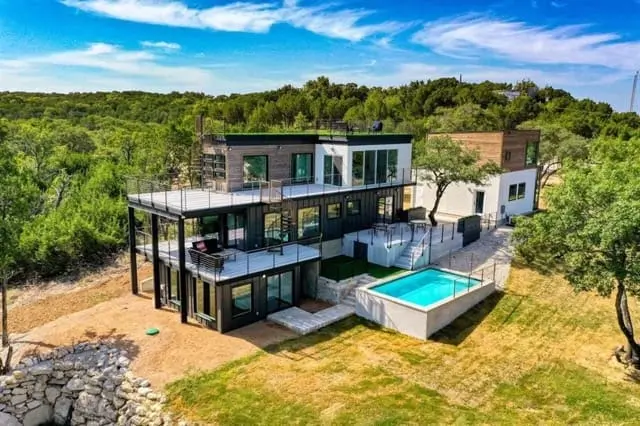
The idea was familiar as the first official record of a shipping container home; we find a man named Phillip Clark.
On November 23, 1987, Clark filed a patent called the “Method for converting one or more steel shipping containers into a habitable building.”
You can read more about the history of the shipping container here.
There are 17 million containers globally, with only 6 million being used for transport.
There is a massive opportunity in repurposing the 11 million old shipping containers just sitting somewhere instead of buying a new container.
There are also many companies to purchase a used container from, and they will deliver it to your site.

Planning the Bedroom Layout for a Shipping Container Home
Considerations when planning a bedroom in a shipping container home
When planning a bedroom in a shipping container home, the primary considerations are maximizing space and creating a comfortable sleeping area.
This can be achieved by choosing a functional bed, such as a Murphy bed, and creating a designated sleeping area separate from the living space.
How to maximize bedroom space in a shipping container home
Maximizing bedroom space in a shipping container home can be achieved by using space-saving furniture and creating a designated sleeping area.
It is also important to use storage solutions, such as under-bed storage, to reduce clutter and keep the room organized.
What are the benefits of living in a shipping container home?
One of the main benefits of building shipping container homes is the cost-effective approach to the price per square foot to build.
The average cost of a shipping container home is significantly lower than a traditional home.
This affordability is perfect for those who want to create a livable space on their property to rent as an Airbnb rental or detached guest house.
I have even seen a few empty nesters moving into the container home and renting out the main house for income.
According to Container-xchange.com, depending on your location, you can find a brand new 20ft container between the range of $1,500 to $3,500.
A new 40-foot container will cost between $2,500 and $4,500, and a new 40-foot high cube (HC) container will cost around $2,500 to $6,000.
The 40-foot option is a no-brainer since you can get double the space without paying double the price.
A used shipping container can be purchased for less than a new one and positively impact the environment by recycling.
The unique styles and home designs that people have created are truly amazing. Metal boxes can be used to create a dream home.

What are the challenges of living in a shipping container home?
The main challenge of living in a shipping container home is maximizing space. Shipping container homes are typically smaller than traditional homes, with limited furniture space.
Your room must be designed strategically unless you combine several containers to create a larger area with two or three bedrooms.
This is why choosing functional and space-saving furniture is essential. It all starts with the bed, because we all need to sleep. The proper layout can go a long way.
How to Maximize Space in a Shipping Container Home?
Design tips for a shipping container home
Keeping the layout open and functional when designing a shipping container home is crucial. This can be achieved using multi-purpose furniture and creating zones for specific activities.
For example, the living area can also be a dining area. You can use software to design the interior and floor plan of your small space.
As simple as a regular original container can be, the designs dreamed up are incredible. Check out some shipping container home plans and designs around the world.
Check out some shipping container home plans and designs around the world.

Best furniture pieces for a shipping container home
The best furniture pieces for a shipping container home are space-saving and functional.
For instance, a sofa bed can double as a seating area during the day and a bed at night.
Storage ottomans can also be used as extra seating and provide additional storage space.

Conclusion
In conclusion, choosing the best bed for your shipping container home involves considering available space, functionality, comfort, and personal preferences.
Whether you opt for a platform bed, loft bed, Murphy bed, convertible furniture, or custom-built solution, each option has advantages and disadvantages.
By carefully evaluating your needs and considering the pros and cons of each bed type, you can create a comfortable and functional sleeping area in your shipping container home. There is no need to compromise your style and needs in a small space.
The question now is, now that you know what the best beds for shipping container homes are, which one will you pick?
Frequently Asked Questions
How many beds can fit in a container?
Depending on the layout, you can fit several beds in a container home.
What is a shipping container home?
A shipping container home is a type of tiny home that is made by converting shipping containers into living spaces.
What are the most popular floor plans for shipping container homes?
The most popular floor plans for shipping container homes include open-concept designs and those with separate bedroom and living spaces.
Can shipping container homes have multiple levels?
Yes, shipping container homes can have multiple levels. Many container homes are made from two or more containers stacked on top of each other.
How can I bring natural light into my shipping container home?
You can bring in natural light to your shipping container home by adding windows, skylights, or even a glass wall.
How can I create a focal point in my shipping container home?
You can create a focal point in your shipping container home by adding a unique feature, such as a statement piece of furniture like a bed with custom accents.
Are shipping container homes suitable for a weekender or guest bedroom?
Yes, shipping container homes can make a great weekender or guest bedroom. With the right floor plan and design, they can be roomy and functional.
Image Source: Canva, Pexels, Pixabay, Open Verse, Unsplash

